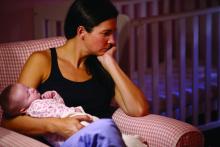CHICAGO – according to Nerissa S. Bauer, MD, MPH.
Postpartum depression is the best known mood disorder related to pregnancy, but it’s not the only one. Perinatal mood and anxiety disorders exist along a spectrum, she told attendees at the American Academy of Pediatrics annual meeting. That spectrum includes prenatal depression, prenatal anxiety, “baby blues,” postpartum depression, posttraumatic stress disorder (PSTD), and postpartum anxiety with panic attacks and/or obsessive-compulsive disorder (OCD).
Baby blues in mothers after delivery – temporary, mild symptoms of depression that don’t interfere with caring for the baby and aren’t cause for alarm – are a normal occurrence and have been reported worldwide. About 50%-80% of women experience baby blues. These symptoms tend to peak around 5 days post partum. “Pediatricians can provide reassurance, emotional support, and demystification” in helping women cope with baby blues, said Dr. Bauer, a pediatrician at Indiana University, Indianapolis.Postpartum mood disorders
Postpartum depression (PPD), however, is serious and requires intervention. An estimated 10%-20% of new mothers experience PPD, but the numbers are much higher in at-risk communities. Up to 48% of mothers in low-income households and 40%-60% of adolescent mothers in low-income households experience it. Yet only about 15% of these higher-risk women seek treatment for PPD (Pediatrics. 2010 Nov;126[5]:1032-9).
PPD symptoms are similar to the usual symptoms of a depressive disorder: depressed mood, irritability, changes in sleep and/or appetite, fatigue, sleepiness, loss of interest in activities, inability to feel pleasure in everyday life, guilt, difficulty concentrating, indecisiveness, low energy, despair, and feelings of worthlessness. The biggest difference – and most important symptom – is that women with PPD may have thoughts about harming not only themselves but also their child. This symptom calls for immediate intervention and sometimes can be a sign of postpartum psychosis.
Postpartum psychosis is rare, occurring in about 1-3 out of 1,000 women, but its seriousness requires immediate medical attention, including hospitalization in most cases. The best established risk factor is preexisting bipolar disorder. Postpartum psychosis usually occurs in the first 4 weeks after delivery, with symptoms that include paranoia, severe mood shifts, hallucinations, delusions, and suicidal and/or homicidal thoughts.
Fathers also can experience depression after a baby’s birth: An estimated 6% of fathers develop paternal depression, but the numbers are triple that among fathers whose children are enrolled in Early Head Start programs, Dr. Bauer said. Paternal depression often co-occurs with postpartum maternal depression, particularly when poverty and substance abuse are contributing factors.
Fewer practitioners may be aware of postpartum anxiety disorders, even though they affect 9%-30% of women. These disorders include generalized anxiety disorder, OCD, and PTSD, either as a preexisting diagnosis or occurring after delivery. Women develop an intensive fear about their child’s well-being and worry that they aren’t able to parent adequately or effectively (Zero to Three. 2009 May:1-6).
Your role in screening mothers
It’s essential that you screen parents for depression, particularly mothers for PPD, because of the potential negative consequences for the child. Research has shown that children of mothers with PPD are at risk for failure to thrive, and have a greater likelihood of mental health conditions, developmental delays, lower IQ scores, sleep problems, and difficulties at school (Infant Behav Dev. 2011 Feb;34[1]:1-14). Further, mothers with PPD are less likely to breastfeed and more likely to stop breastfeeding early, studies have shown (Arch Pediatr Adolesc Med. 2006 Mar;160[3]:279-84).
The risk factors for PPD often occur together, with each additional one adding to the overall risk. As incidence estimates show, teens and those with low income are at higher risk, as are those with less education and any type of additional financial hardship. Other factors that increase women’s risk include interpersonal violence, a lack of social support, a history or family history of anxiety or depression, poor physical or mental health in general, and substance abuse (Depress Anxiety. 2017 Feb;34[2]:178-87).
Treatment for postpartum depression or anxiety can include medication (typically with SSRIs), therapy, a visit to the patient’s ob.gyn., or referral to crisis intervention or a psychiatrist, psychologist, or other mental health professional.“Early treatment shows best results,” Dr. Bauer said. Yet less than half of mothers experiencing PPD seek treatment for it.
“Mothers may feel they ‘are strong enough’ and do not need help,” Dr. Bauer said. Or they feel they have to use what limited energy they have on their baby, or they worry about being “labeled as crazy or unable to care for their baby,” she said. Cultural factors also can play a role in this reticence to seek help (Qual Health Res. 2008 Sep;18[9]:1161-73).
“However, mothers are receptive to communication with their child’s pediatrician,” Dr. Bauer said, creating an opportunity for screening that mothers may not otherwise get.



